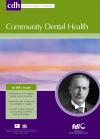Community Dental Health

- Cover Date:
- September 2009
- Print ISSN:
- 0265 539X
- Vol:
- 26
- Issue:
- 3
The prevalence and severity of dental fluorosis in the high and low altitude parts of Central Plateau, Nigeria
Objective To compare the prevalence and severity of dental fluorosis in the high and low altitude parts of the Central Senatorial District of Plateau State. Basic research design The study was cross-sectional and descriptive. Setting The community based study was carried out in Central Plateau Nigeria, in 2005. Participants The study subjects were 12-15 year old life long residents selected using the multistage sampling technique. One Local Government Area each was randomly selected from the high and low altitude parts of the district and from each selected Local Government Area two health districts were randomly selected with probability proportional to size. From each of the selected health Districts two major settlements were selected again with probability proportional to size. 12-15 year old life long residents of the selected settlements were studied. Each respondent completed an interviewer administered questionnaire after which he/she was clinically examined to ascertain his/her fluorosis status. Samples of water were collected from water sources consumed by the respondents in each settlement. Main outcome measures The main outcome measures were presence and severity of dental fluorosis as measured by the Thylstrup and Fejerskov index. (TF score). Results. One thousand one hundred children were studied, 554 (50.4%) from the high altitude part of the district and 546 (49.6%) from the low altitude part. Fluorosis prevalence was 12.9% in the district, but significantly higher (22.2%) in the high altitude areas compared to the low altitude ones (3.5%). The severest form of fluorosis in the district was TF 6 for tooth 14 and TF 5 for tooth 11. Conclusion. The prevalence and severity of dental fluorosis is significantly higher in the high altitude parts of the District compared to the low altitude ones. Efforts are needed to further investigate and control the problem.
Key words: Central Plateau, dental fluorosis, prevalence, severity
- Article Price
- £15.00
- Institution Article Price
- £
- Page Start
- 138
- Page End
- 142
- Authors
- T. J. Akosu, A. I. Zoakah, O. A. Chirdan
Articles from this issue
- Title
- Pg. Start
- Pg. End
- The fractional urinary fluoride excretion of adults consuming naturally and artificially fluoridated water and the influence of water hardness: A randomized trial.
- 132
- 137
- The prevalence and severity of dental fluorosis in the high and low altitude parts of Central Plateau, Nigeria
- 138
- 142
- Prevalence of enamel defects related to pre-, peri- and postnatal factors in a Brazilian population.
- 143
- 149
- Development of a psychometric scale to assess satisfaction with dental care among Sri Lankans
- 150
- 156
- Consent of older children participating in BASCD coordinated dental epidemiology surveys in Wales.
- 157
- 161
- A comparison of Personal Dental Service (PDS) and General Dental Service (GDS) patients in terms of reported interventions, oral health and dentists’ perceptions
- 170
- 176
- Hopelessness, depression and oral health concerns reported by community dwelling older Australians
- 177
- 182
- Higher-order exploratory factor analysis of the Dental Subscale of Children’s Fear Survey Schedule in a Taiwanese population.
- 183
- 187
